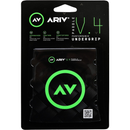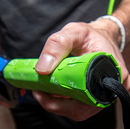The best padel rackets of 2022/23 - delivery in 72h
con consegna in 72h!
Starvie
Siux
In tendenza
Vai al prodottoIn offerta
Paddle accessories
Padel bags and backpacks
What should your first padel racket look like?
Stiffness
The stiffness of the racket is due to several elements: the elasticity of the point of impact, and the softness of the internal material. A softer racket will allow you to generate more ball speed with less effort. Contrary to what it may seem, this is not an invitation to hit even harder! Indeed, it is what will allow you not to accelerate the movements, make less effort, have more fun while focusing on the right technique.
Shape
Another very important aspect of your first racket is the shape of the frame: round frames have a larger optimal hitting point ('sweetspot'), one that allows you to enjoy the moment and make fewer mistakes.
How do you find out which padel racket best suits your style of play?
Why switch to an intermediate racket?
Your padel racket must keep up with your level of play. As you begin to feel more confident in your skills, it becomes easier to understand what you want from your racket, and what you would like to avoid. The specific characteristics are increasingly clear, as is their impact on the court. Having the possibility to choose the particularities of a racket according to one's needs, preferences and abilities, is the first step in raising one's level of competitiveness. You can finally decide to choose a harder racket to manage that has more overall potential. Likewise, thanks to the habit and resistance developed through playing consistently, you will able to approach a more skillfull racket without increasing the risk of injury.How do you identify a racket with more specific characteristics?
Most intermediate rackets are very well rounded, i.e. balanced between their strengths and weaknesses. However, the details make all the difference. In this section you will start to see more differences between control rackets and power rackets, or between smooth racket-faces and rougher ones. Furthermore, the rackets have more durability as they are made with better quality materials.Balancing
Balance is one of the main factors in distinguishing a racket that is easier to swing from one that produces more power at the cost of a little control. A central balance usually corresponds to control rackets, because it facilitates coordination and shot-execution. Rackets that require more effort and allow you to hit harder tend to have the balance shifted slightly towards the racket head, thus creating a longer leverage.Stiffness
As mentioned for beginner rackets, stiffness can depend on numerous structural elements of the racket. The interiors are usually made of different kinds of rubber or foams, that have different softness in relation on the material of the external plate. The racket face is usually made of carbon fiber (sometimes combined with layers of different materials, depending on the model) or glass fibre. Fiberglass is the most elastic material used for padel rackets, followed by the most popular 3K carbon fiber, while 12K carbon fiber is the least flexible. A harder consistency corresponds to a more powerful racket, if you are able to produce the necessary arm-acceleration. Instead, a softer consistency corresponds to a racket capable of cushioning more powerful shots while also helping you 'push' slower balls, and which requires less overall effort.
Shape
The distinctions between different racket frames start becoming more and more important as the level of play rises.There can be round, round hybrid, teardrop and diamond frames. In that order, you move through control rackets to more powerful rackets. The shape is closely related to the overall balance and the position and extension of the sweet spot. Round framed rackets tend to have a more centred balance and a larger sweet spot. Teardrop and diamond framed rackets naturally tend to have their weight tilted towards the racket head, as well as having a slightly reduced sweet spot.
How to choose the padel racket that enhances your best shots
When to switch to a professional racket
The rackets that are recommended for an advanced level of play respond to increasingly specific needs, but require a very high level of preparation, technique and knowledge to be exploited to their full potential. As your level of play rises, there will come a time when a high-end racket becomes the only way for your skills to truly blossom. It is therefore necessary to examine the benefits of switching to a professional racket on multiple levels: the athletic and technical struggle of transitioning to more complex equipment, and the ability to identify a racket whose characteristics are in accordance with your style of play.How do you identify a professional racket?
There are various parameters that will help you identify an advanced level racket. Rackets of this level tend to have increasingly unique and specific characteristics. In this category, diamond and teardrop rackets are more common, balancing is shifted towards the head of the racket on most occasions. Furthermore, elements such as the surface of the plate or the heart of the racket often feature specific technologies depending on the brand or model. Finally, professional rackets are manufactured with the highest quality materials. This makes them extremely resistant to time and impacts.Balancing
The balance of the racket depends on the intended style of play. Rackets that are intended for an attacking style of play tend to be tilted towards the head of the racket, as opposed to control rackets, which are often balanced in the centre or towards the grip. Also, top tier rackets are usually heavier.Shape
Same goes for the shape of the racket, which is designed accordingly to the style of play. Among the advanced padel there are many teardrop and diamond frames, which are the two most suitable shapes for an offensive game. There are of course also numerous round models for control rackets, as well as some hybrid shapes.
Stiffness
Among the advanced level rackets, you will find a great variety of internal and external stiffness. Thanks to the improvement of the quality of the materials, it is possible to find different values of rigidity obtained through different combinations. For example, harder racket faces may be matched to softer internal rubbers and viceversa. You will also find different combinations of carbon fiber and glass fiber layers for the platter (or even alluminium, basalt and other), as well as various types of internal rubbers.
Special technologies
As anticipated, within this range of rackets you will be able to find multiple structural elements specifically created for a given model. For example, there are unique technologies for the heart of most racquet, which are able to absorb more vibrations, as well as lightening the perceived-weight during a stroke. Among other examples you will find the hole pattern, the length of the grip, and especially the texture of the surface of the racket face, which greatly influences the spin output.Vuoi iscriverti alla mailing list di BORN2PADEL?
Inserisci la tua email e riceverai aggiornamenti su inventario, promozioni, saldi, voucher e tanto altro...



























































